- GCN/BACODINE POSITION NOTICE
TITLE: GCN/SWIFT NOTICE
NOTICE_DATE: Tue 27 Dec 05 18:07:37 UT
NOTICE_TYPE: Swift-BAT GRB Position
TRIGGER_NUM: 174738, Seg_Num: 0
GRB_RA: 125.270d {+08h 21m 05s} (J2000),
125.364d {+08h 21m 27s} (current),
124.487d {+08h 17m 57s} (1950)
GRB_DEC: +31.929d {+31d 55' 44"} (J2000),
+31.910d {+31d 54' 35"} (current),
+32.088d {+32d 05' 18"} (1950)
GRB_ERROR: 3.00 [arcmin radius, statistical only]
GRB_INTEN: 6018 [cnts] Image_Peak=323 [image_cnts]
TRIGGER_DUR: 1.024 [sec]
TRIGGER_INDEX: 146 E_range: 25-100 keV
BKG_INTEN: 34422 [cnts]
BKG_TIME: 65224.00 SOD {18:07:04.00} UT
BKG_DUR: 8 [sec]
GRB_DATE: 13731 TJD; 361 DOY; 05/12/27
GRB_TIME: 65236.04 SOD {18:07:16.04} UT
GRB_PHI: -27.73 [deg]
GRB_THETA: 20.99 [deg]
SOLN_STATUS: 0x3
RATE_SIGNIF: 22.82 [sigma]
IMAGE_SIGNIF: 10.59 [sigma]
MERIT_PARAMS: +1 +0 +0 +0 +2 +8 +0 +0 +89 +1
SUN_POSTN: 276.64d {+18h 26m 33s} -23.30d {-23d 17' 51"}
SUN_DIST: 153.22 [deg]
MOON_POSTN: 228.36d {+15h 13m 26s} -21.46d {-21d 27' 38"}
MOON_DIST: 111.78 [deg]
MOON_ILLUM: 14 [%]
GAL_COORDS: 190.55, 31.95 [deg] galactic lon,lat of the burst (or
+transient)
ECL_COORDS: 120.08, 12.10 [deg] ecliptic lon,lat of the burst (or
+transient)
COMMENTS: SWIFT-BAT GRB Coordinates.
COMMENTS: This is a rate trigger.
COMMENTS: A point_source was found.
COMMENTS: This does not match any source in the on-board catalog.
COMMENTS: This does not match any source in the ground catalog.
COMMENTS: This is a GRB.
COMMENTS: This trigger occurred at longitude,latitude = 150.20,-19.85 [deg].
- red DSS finding chart
ps-file
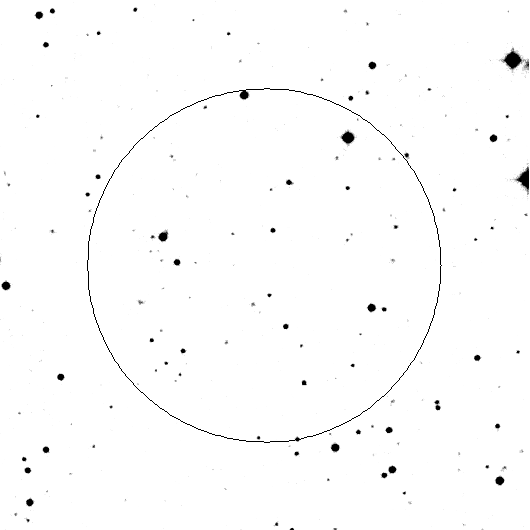
- GCN NOTICE
TITLE: GCN/SWIFT NOTICE
NOTICE_DATE: Tue 27 Dec 05 18:09:23 UT
NOTICE_TYPE: Swift-XRT Position
TRIGGER_NUM: 174738, Seg_Num: 0
GRB_RA: 125.2401d {+08h 20m 57.6s} (J2000),
125.3338d {+08h 21m 20.1s} (current),
124.4568d {+08h 17m 49.6s} (1950)
GRB_DEC: +31.9260d {+31d 55' 33.5"} (J2000),
+31.9067d {+31d 54' 24.2"} (current),
+32.0851d {+32d 05' 06.3"} (1950)
GRB_ERROR: 5.8 [arcsec radius, statistical plus systematic, 90% containment]
GRB_INTEN: 1.12e-09 [erg/cm2/sec]
GRB_SIGNIF: 6.70 [sigma]
IMG_START_DATE: 13731 TJD; 361 DOY; 05/12/27
IMG_START_TIME: 65329.29 SOD {18:08:49.29} UT, 93.2 [sec] since BAT Trigger Time
TAM[0-3]: 327.64 237.24 261.26 242.94
AMPLIFIER: 2
WAVEFORM: 134
SUN_POSTN: 276.64d {+18h 26m 33s} -23.30d {-23d 17' 51"}
SUN_DIST: 153.25 [deg]
MOON_POSTN: 228.38d {+15h 13m 30s} -21.47d {-21d 27' 57"}
MOON_DIST: 111.82 [deg]
MOON_ILLUM: 14 [%]
GAL_COORDS: 190.54, 31.92 [deg] galactic lon,lat of the burst
ECL_COORDS: 120.05, 12.09 [deg] ecliptic lon,lat of the burst
COMMENTS: SWIFT-XRT Coordinates.
COMMENTS: WARNING: XRT alignment calibration is on-going, and there may be
COMMENTS: residual systematic offsets of several arcseconds not accounted for yet
COMMENTS: by our on-board position determination algorithm. We have increased
COMMENTS: the estimated error circle radius to take this into account.
- GCN NOTICE
TITLE: GCN/SWIFT NOTICE
NOTICE_DATE: Tue 27 Dec 05 18:10:49 UT
NOTICE_TYPE: Swift-BAT GRB Lightcurve
TRIGGER_NUM: 174738, Seg_Num: 0
GRB_RA: 125.270d {+08h 21m 05s} (J2000),
125.364d {+08h 21m 27s} (current),
124.487d {+08h 17m 57s} (1950)
GRB_DEC: +31.929d {+31d 55' 44"} (J2000),
+31.910d {+31d 54' 35"} (current),
+32.088d {+32d 05' 18"} (1950)
GRB_DATE: 13731 TJD; 361 DOY; 05/12/27
GRB_TIME: 65236.04 SOD {18:07:16.04} UT
TRIGGER_INDEX: 146
GRB_PHI: -27.73 [deg]
GRB_THETA: 20.99 [deg]
DELTA_TIME: 65460.00 [sec]
TRIGGER_DUR: 1.024 [sec]
LC_URL: sw00174738000msb.lc
SUN_POSTN: 276.64d {+18h 26m 33s} -23.30d {-23d 17' 51"}
SUN_DIST: 153.22 [deg]
MOON_POSTN: 228.39d {+15h 13m 33s} -21.47d {-21d 28' 13"}
MOON_DIST: 111.81 [deg]
MOON_ILLUM: 14 [%]
GAL_COORDS: 190.55, 31.95 [deg] galactic lon,lat of the burst (or transient)
ECL_COORDS: 120.08, 12.10 [deg] ecliptic lon,lat of the burst (or transient)
COMMENTS: SWIFT-BAT GRB Lightcurve.
COMMENTS:
COMMENTS: The next comments were copied from the BAT_POS Notice:
COMMENTS: This is a rate trigger.
COMMENTS: A point_source was found.
COMMENTS: This does not match any source in the on-board catalog.
COMMENTS: This does not match any source in the ground catalog.
COMMENTS: This is a GRB.
COMMENTS: This trigger occurred at longitude,latitude = 150.20,-19.85 [deg].
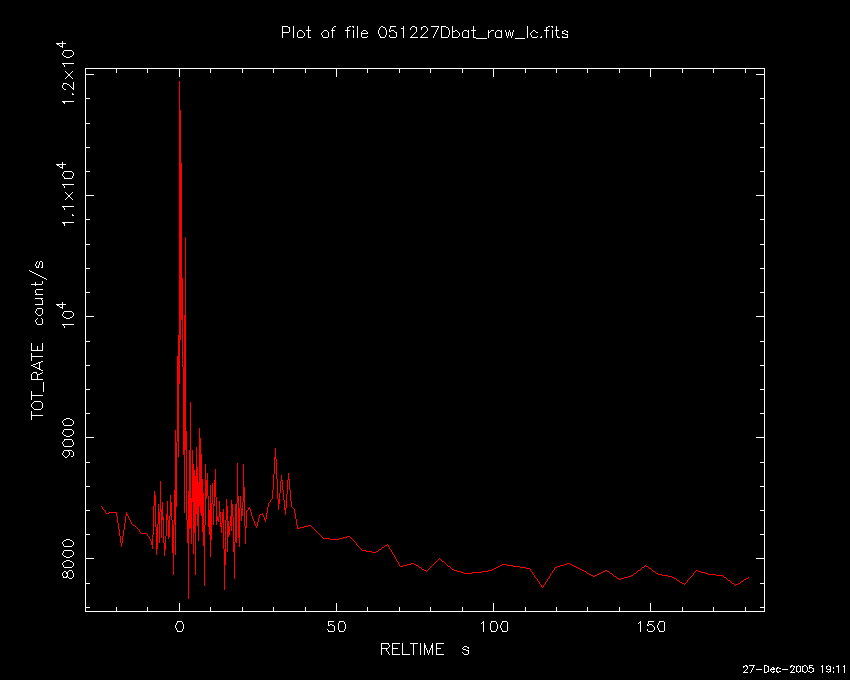
- GCN NOTICE
TITLE: GCN/SWIFT NOTICE
NOTICE_DATE: Tue 27 Dec 05 18:12:40 UT
NOTICE_TYPE: Swift-UVOT Source List
TRIGGER_NUM: 174738, Seg_Num: 0
POINT_RA: 125.249d {+08h 20m 60s} (J2000)
POINT_DEC: +31.901d {+31d 54' 05"} (J2000)
POINT_ROLL: 78.339d
IMG_START_DATE: 13731 TJD; 361 DOY; 05/12/27
IMG_START_TIME: 65332.53 SOD {18:08:52.53} UT, 96.5 [sec] since BAT Trigger Time
FILTER: 3, V
BKG_MEAN: 0.908
N_STARS: 55
X_OFFSET: 305 [pixels]
Y_OFFSET: 630 [pixels]
X_MAX: 1264 [pixels]
Y_MAX: 1589 [pixels]
DET_THRESH: 8
PHOTO_THRESH: 4
SL_URL: sw00174738000msufc0096.fits
SUN_POSTN: 276.64d {+18h 26m 34s} -23.30d {-23d 17' 51"}
SUN_DIST: 153.25 [deg]
MOON_POSTN: 228.41d {+15h 13m 38s} -21.48d {-21d 28' 33"}
MOON_DIST: 111.84 [deg]
MOON_ILLUM: 14 [%]
GAL_COORDS: 190.57, 31.92 [deg] galactic lon,lat of the pointing direction
ECL_COORDS: 120.07, 12.07 [deg] ecliptic lon,lat of the pointing direction
COMMENTS: SWIFT-UVOT Source List.
- GCN NOTICE
TITLE: GCN/SWIFT NOTICE
NOTICE_DATE: Tue 27 Dec 05 18:13:27 UT
NOTICE_TYPE: Swift-UVOT Image
TRIGGER_NUM: 174738, Seg_Num: 0
POINT_RA: 125.249d {+08h 20m 60s} (J2000)
POINT_DEC: +31.901d {+31d 54' 05"} (J2000)
ROLL: 78.339d
IMG_START_DATE: 13731 TJD; 361 DOY; 05/12/27
IMG_START_TIME: 65332.53 SOD {18:08:52.53} UT, 96.5 [sec] since BAT Trigger Time
FILTER: 3, V
EXPOSURE_ID: 157399732
X_OFFSET: 625 [pixels]
Y_OFFSET: 950 [pixels]
WIDTH: 160 [pixels]
HEIGHT: 160 [pixels]
X_GRB_POS: 785
Y_GRB_POS: 1110
BINNING_INDEX: 1
IM_URL: sw00174738000msuni0096.fits
SUN_POSTN: 276.64d {+18h 26m 34s} -23.30d {-23d 17' 50"}
SUN_DIST: 153.25 [deg]
MOON_POSTN: 228.41d {+15h 13m 39s} -21.48d {-21d 28' 42"}
MOON_DIST: 111.85 [deg]
MOON_ILLUM: 14 [%]
GAL_COORDS: 190.57, 31.92 [deg] galactic lon,lat of the pointing direction
ECL_COORDS: 120.07, 12.07 [deg] ecliptic lon,lat of the pointing direction
COMMENTS: SWIFT-UVOT Image.
COMMENTS: The GRB Position came from the XRT Position Command.
COMMENTS: The image has 2x2 binning (compression).

- GCN NOTICE
TITLE: GCN/SWIFT NOTICE
NOTICE_DATE: Tue 27 Dec 05 18:13:50 UT
NOTICE_TYPE: Swift-UVOT Processed Source List
TRIGGER_NUM: 174738, Seg_Num: 0
POINT_RA: 125.249d {+08h 20m 60s} (J2000)
POINT_DEC: +31.901d {+31d 54' 05"} (J2000)
POINT_ROLL: 78.339d
IMG_START_DATE: 13731 TJD; 361 DOY; 05/12/27
IMG_START_TIME: 65332.53 SOD {18:08:52.53} UT, 96.5 [sec] since BAT Trigger Time
FILTER: 3, V
BKG_MEAN: 0.908
N_STARS: 55
X_OFFSET: 305 [pixels]
Y_OFFSET: 630 [pixels]
X_MAX: 1264 [pixels]
Y_MAX: 1589 [pixels]
DET_THRESH: 8
PHOTO_THRESH: 4
SL_URL: sw00174738000msufc0096.fits
SUN_POSTN: 276.64d {+18h 26m 34s} -23.30d {-23d 17' 50"}
SUN_DIST: 153.25 [deg]
MOON_POSTN: 228.42d {+15h 13m 40s} -21.48d {-21d 28' 46"}
MOON_DIST: 111.85 [deg]
MOON_ILLUM: 14 [%]
GAL_COORDS: 190.57, 31.92 [deg] galactic lon,lat of the pointing direction
ECL_COORDS: 120.07, 12.07 [deg] ecliptic lon,lat of the pointing direction
COMMENTS: SWIFT-UVOT Processed Source List.
COMMENTS: All 4 attachments are included.
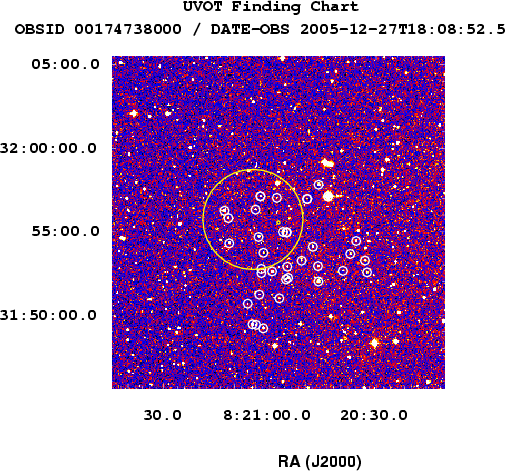
- GCN NOTICE
TITLE: GCN/SWIFT NOTICE
NOTICE_DATE: Tue 27 Dec 05 18:13:47 UT
NOTICE_TYPE: Swift-UVOT Processed Image
TRIGGER_NUM: 174738, Seg_Num: 0
POINT_RA: 125.249d {+08h 20m 60s} (J2000)
POINT_DEC: +31.901d {+31d 54' 05"} (J2000)
ROLL: 78.339d
IMG_START_DATE: 13731 TJD; 361 DOY; 05/12/27
IMG_START_TIME: 65332.53 SOD {18:08:52.53} UT, 96.5 [sec] since BAT Trigger Time
FILTER: 3, V
EXPOSURE_ID: 157399732
X_OFFSET: 625 [pixels]
Y_OFFSET: 950 [pixels]
WIDTH: 160 [pixels]
HEIGHT: 160 [pixels]
X_GRB_POS: 785
Y_GRB_POS: 1110
BINNING_INDEX: 1
IM_URL: sw00174738000msuni0096.fits
SUN_POSTN: 276.64d {+18h 26m 34s} -23.30d {-23d 17' 50"}
SUN_DIST: 153.25 [deg]
MOON_POSTN: 228.42d {+15h 13m 40s} -21.48d {-21d 28' 45"}
MOON_DIST: 111.85 [deg]
MOON_ILLUM: 14 [%]
GAL_COORDS: 190.57, 31.92 [deg] galactic lon,lat of the pointing direction
ECL_COORDS: 120.07, 12.07 [deg] ecliptic lon,lat of the pointing direction
COMMENTS: SWIFT-UVOT Processed Image.
COMMENTS: If you have elected to receive attachments:
COMMENTS: The uvot_catalog_image.fits.gz file does not exist; skipping the attachment.
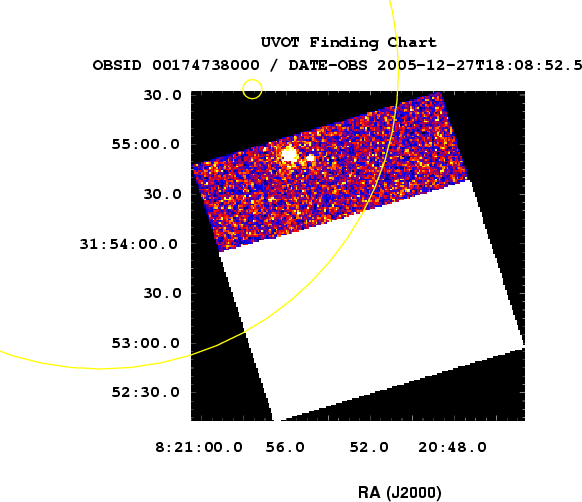
- GCN Circular #4397
L. Barbier (GSFC), S. Barthelmy (GSFC), A. Beardmore (U Leicester),
D. Burrows (PSU), J. Cummings (GSFC/NRC), A. Falcone (PSU), N. Gehrels (GSFC),
K. Page (U Leicester), A. Retter (PSU), P. Roming (PSU),
T. Sakamoto (GSFC)
on behalf of the Swift team:
At 18:07:16 UT, Swift-BAT triggered and located GRB 051227 (trigger=174738).
The spacecraft slewed immediately. The BAT on-board calculated location is
RA,Dec 125.270d,+31.929d {08h 21m 05s,+31d 55' 44"} (J2000), with an uncertainty
of 3 arcmin (radius, 90% containment, stat+sys). The BAT light curve shows
a multi-peak structure with a total duration of at least 8 sec. The peak count
rate was ~3500 counts/sec (15-350 keV), at 0 seconds after the trigger.
The XRT began observing the GRB at 18:08:49 UT, 93s after the BAT trigger.
A bright fading uncataloged source was found by the on-board centroiding
algorithm at:
RA(J2000)= 08h 20m 57.6s
DEC(J2000)= +31d 55' 33.5"
with an uncertainty of 7 arcseconds radius (90% containment). This position
has not been corrected for the XRT boresight and retains a 4-5 arcsecond
residual systematic error, which is included in the 7 arcsecond error radius.
This position lies 95 arcseconds from the centre of the BAT error circle.
The initial X-ray flux is estimated to be 1.1e-9 erg/cm2/sec (0.2-10keV).
UVOT took a finding chart exposure of nominal 200 seconds with the V filter
starting 96 seconds after the BAT trigger. No afterglow candidate
has been found in the initial data products. Image catalog data are not
available at this time. The overlap of the 8'x8' region for the list
of sources generated on-board and the XRT error circle is uncertain.
No correction has been made for the expected visual extinction
of about 0.1 magnitudes.
We note that according to SIMBAD, there is a galactic cluster NSC J082047+315700
within 2.7 arcmin from this location, but this is definitely a long burst
(not a short GRB).
- GCN Circular #4398
E.Sonoda,S.Maeno,S.Masuda,Y.Nakamura,M.Yamauchi
(University of Miyazaki)
"We have observed the field covering the error circle of
GRB 051227 (GCN 4397) with the unfiltered CCD camera on
the 30-cm telescope at University of Miyazaki.
The observation was started 18:27:18 UT on Dec.27.
After co-adding a set of 6 images (18:27:18 - 18:36:21 UT)
of 30 sec exposures, we have compared with the USNO A2.0 catalog.
Preliminary analysis shows there is no new source brighter than 17.6 mag."
- GCN Circular #4399
Richard J. Cool (Arizona), Daniel J. Eisenstein (Arizona), David
W. Hogg (NYU), Michael R. Blanton (NYU), J. Brinkmann (Apache
Point Observatory), Donald P. Schneider (PSU), and Daniel E. Vanden Berk
(PSU) report on behalf of the Sloan Digital Sky Survey (SDSS)
Collaboration:
The Sloan Digital Sky Survey (SDSS) imaged the field of burst
GRB051227 prior to the burst. As these data should be useful
as a pre-burst comparison and for calibrating photometry, we are
supplying the images and photometry measurements for this GRB field
to the community.
Data from the SDSS, including 5 FITS images, 3 JPGS, and
3 files of photometry and astrometry, are being placed at
http://mizar.as.arizona.edu/~grb/public/GRB051227
We supply FITS images in each of the 5 SDSS bands of a 8'x8'
region centered on the GRB position (ra=125.270 (08:21:04.8),
dec=31.9290 (31:55:44.4); Swift-BAT TRIGGER 174738), as well as 3
gri color-composite JPGs (with different stretches). The units in
the FITS images are nanomaggies per pixel. A pixel is 0.396 arcsec
on a side. A nanomaggie is a flux-density unit equal to 10^-9 of
a magnitude 0 source or, to the extent that SDSS is an AB system,
3.631e-6 Jy. The FITS images have WCS astrometric information.
In the file GRB051227_sdss.calstar.dat, we report photometry
and astrometry of 825 bright stars (r<20.5) within 15' of the
burst location. The magnitudes presented in this file are asinh
magnitudes as are standard in the SDSS (Lupton 1999, AJ, 118,
1406). Beware that some of these stars are not well-detected in
the u-band; use the errors and object flags to monitor data quality.
In the files GRB051227_sdss.objects_flux.dat and
GRB051227_sdss.objects_magnitudes.dat, we report photometry
of 2481 objects detected within 6' of the GRB position.
We have removed saturated objects and objects with model
magnitudes fainter than 23.0 in the r-band. The fluxes listed
in GRB051227_sdss.objects_flux.dat are in nanomaggies while the
magnitudes listed in GRB051227_sdss.objects_magnitudes.dat are
asinh magnitudes.
All quantities reported are standard SDSS photometry, meaning that
they are very close to AB zeropoints and magnitudes are quoted
in asinh magnitudes. Photometric zeropoints are known to about
2% rms. None of the photometry is corrected for dust extinction.
The Schlegel, Finkbeiner, and Davis (1998) predictions for this
region are A_U=0.213 mag, A_g=0.157 mag, A_r = 0.114 mag, A_i=0.086
mag, and A_z=0.061 mag.
The file GRB051227_sdss.spectro.dat contains a list of the 4 objects
with SDSS spectroscopy within 6 arcminutes of the GRB position.
In addition to the redshift and 1-sigma error for each object,
this file also lists the object spectroscopic classification.
SDSS astrometry is generally better than 0.1 arcsecond per
coordinate. Users requiring high precision astrometry should take
note that the SDSS astrometric system can differ from other systems
such as those used in other notices; we have not checked the offsets
in this region.
See the SDSS DR4 documentation for more details:
http://www.sdss.org/dr4
- GCN Circular #4400
D. Hullinger (GSFC/UMD), L. Barbier (GSFC), S. Barthelmy (GSFC),
P. Boyd (GSFC-UMBC), J. Cummings (GSFC/NRC), E. Fenimore (LANL),
N. Gehrels (GSFC), H. Krimm (GSFC/USRA), C. Markwardt (GSFC/UMD),
D. Palmer (LANL), A. Parsons (GSFC), T. Sakamoto (GSFC/NRC),
G. Sato (ISAS), J. Tueller (GSFC), W. Voges (MPE)
on behalf of the Swift-BAT team:
Using the full data set from the recent telemetry downlink, we report
further analysis of Swift-BAT GRB 051227 (trigger #174738)
(Barbier, et al., GCN 4397). The ground-analysis position is
RA,Dec 125.230,+31.953 {08h 20m 55.2s,+31d 57' 12"} (J2000)
with an uncertainty of 1.8 arcmin (radius, 90%, stat+sys).
T90 is 8.0 +- 0.2 sec. The partial coding fraction is 97%.
The lightcurve has an initial multi-peak structure at T+0.00 sec
(FWHM of ~3.5 sec) and there is a smaller broad softer peak spanning
T+30 to T+50 sec. Fitting a simple power law over the full interval
from T-1 to T+8 sec, the photon index is 1.31 +/- 0.22 with a fluence
of 2.3 +/- 0.3 X 10^-7 erg/cm^2. The peak flux in a 1-sec wide window
starting at T-0.008 sec is 0.97 +/- 0.13 ph/cm^2/sec. All values are
in the 15-150 keV band at the 90% confidence level.
- GCN Circular #4401
S. Barthelmy (GSFC), N. Gehrels (GSFC), J. Norris (GSFC),
T. Sakamoto (GSFC/NRC)
on behalf of the Swift-BAT team:
Continuing the analysis of GRB 051227, we point out the possibility
that this is a short burst. We do not have the full data set downloaded
for this burst yet (only T-60 to T+120 sec), but we wish to get this
speculation out to the follow-up community to facilitate observations
as soon as possible (i.e. CA coast and Hawaii big glass).
We base this on 2 observations:
1) The spectral lag is negligible, 2+-10 ms (1 sigma), between the
25-50 and 100-350 keV energy bands -- typical of spectral lags
in short bursts (Norris & Bonnell, submitted to ApJ). The median lag
for long bursts is 50 ms, and only 1% of long bursts have a lag less than 2 ms.
2) The overall shape of the lightcurve of GRB 051227 is similar
to the lightcurve of the short hard burst GRB 050724. The initial hard spike
is followed by 1 or 2 smaller short peaks at delays of one to several seconds.
Then a period of hiatus, followed by a broad low-level soft emission emission
that starts at a few tens of seconds out to 100+ seconds. However, we can not
rule out that this is a FRED-like profile with a very long low-statistics
decay tail.
- GCN Circular #4402
A. Beardmore (U. Leicester), D. N. Burrows (PSU), K. Page (U. Leicester),
F. Marshall (GSFC), M. Chester (PSU) report on behalf of the Swift XRT team:
We have analysed the first 3 orbits of XRT data from GRB 051227.
A 2.8ks photon counting mode image provides a refined XRT position:
RA(J2000) = 08h 20m 57.92s,
Dec(J2000) = +31d 55m 30.43s
with an uncertainty of 3.5 arcsec (90% containment). This position is 5.1
arcsec away from the on-board XRT position quoted in Barbier et al.
(GCN4397) and includes the latest XRT boresight correction. This position
is 106 arcseconds from the refined BAT position (Hullinger et al., GCN 4400).
The X-ray light curve displays multiple small flares, with the largest
peaking at a count rate of approximately 25 counts/s at T + 115s
(where T is the BAT trigger time). The underlying decay can be fit
with a broken power-law with an initial decay slope of -2.2+/-0.2, a
break at 475+235-80s, and a post-break slope of -0.95+/-0.15.
A power-law fit to the X-ray spectrum from T + 101s to T + 180s
gave a photon index of 1.4+/-0.2 and a column density of
(1.8+/-1.0)e21 cm**-2. We note the galactic hydrogen column density in the
direction of the burst is 4.3e20cm**-2. The 0.2-10.0keV observed flux was
4.2e-10 ergs cm**-2 s**-1, which corresponds to an unabsorbed flux of
5.0e-10 ergs cm**-2 s**-1.
If the burst continues decaying at the current rate we estimate an XRT
count rate of 0.0022 counts/s at T + 24hr, which corresponds to an
observed 0.2-10.keV flux of 1.1e-13 ergs cm**-2 s**-1.
- GCN Circular #4403
GRB 051227: Joint Swift-HETE Spectral Analysis
T. Sakamoto, J-L. Atteia, G. Ricker, N. Kawai, D. Lamb, and S. Woosley,
on behalf of the HETE Science Team;
M. Arimoto, T. Donaghy, E. Fenimore, M. Galassi, C. Graziani,
N. Ishikawa, A. Kobayashi, J. Kotoku, M. Maetou, M. Matsuoka,
Y. Nakagawa, R. Sato, T. Shimokawabe, Y. Shirasaki, S. Sugita,
M. Suzuki, T. Tamagawa, K. Tanaka, and A. Yoshida, on behalf of the
HETE WXM Team;
N. Butler, G. Crew, J. Doty, G. Prigozhin, R. Vanderspek,
J. Villasenor, J. G. Jernigan, A. Levine, G. Azzibrouck, J. Braga,
R. Manchanda, G. Pizzichini, and S. Gunasekera, on behalf of the HETE
Operations and HETE Optical-SXC Teams;
M. Boer, J-F Olive, J-P Dezalay, and K. Hurley, on behalf of the HETE
FREGATE Team;
L. Barbier, S. Barthelmy, J. Cummings, N. Gehrels, and J. Norris, on
behalf of the Swift BAT team;
report:
The HETE FREGATE instrument detected the initial peak of GRB 051227
(Swift Trigger 174738; Barbier, et al., GCN 4397) as an untriggered
event.
Carrying out a fit to the FREGATE spectral data alone, the spectrum
of the initial peak is adequately fit by a power-law (PL) model, with
photon index alpha = 1.3 +0.4/-0.6 (90% confidence level). This
confirms the result reported by Hullinger et. al (GCN 4400).
Carrying out a joint fit to the BAT plus FREGATE spectral data, the
best-fit cutoff PL model yields an improvement in ch^i2 over the
best-fit PL model of 5.2 for one additional parameter, corresponding
to a significance of 2.3E-02. Thus the joint spectral fit provides
evidence of curvature in the spectrum.
Adopting the best-fit cutoff PL model yields a best-fit value of
Epk = 100 +219/-41.3 keV (90% confidence level) and a fluence ratio
S(2 keV-30 keV)/S(30 keV-400 keV) = 0.19. The event is therefore a
hard GRB.
- GCN Circular #4404
D. Malesani (SISSA), S. Piranomonte, L.A. Antonelli (INAF/OAR), E.
Depagne, C. Lidman, C. Melo (ESO), S. Campana, S. Covino, G. Tagliaferri
(INAF/OABr), G. Chincarini (Univ. Milano-Bicocca), M. Della Valle
(INAF/OAA), F. Fiore, and L. Stella (INAF/OARm), report on behalf of the
MISTICI collaboration:
We observed the field of the hard (and possibly short) GRB 051227
(Barbier et al., GCN 4397; Barthelmy et al., GCN 4401; Sakamoto et al.,
GCN 4403) using the ESO VLT-UT2 (Kueyen) equipped with the FORS1
instrument. Observations started on 2005 Dec 28, 04:22 UT (~10.3 h after
the GRB), in the R band. Observations were conducted at high airmass and
moderate seeing (1.5").
Coadding three 5-min images, we detect inside the revised XRT error
circle (Beardmore et al., GCN 4402) one single, faint source, at the
coordinates (J2000):
alpha = 08:20:58.14
delta = +31:55:31.7
The astrometric error is about 0.5". This object is not seen in the
r-band SDSS images provided by Cool et al. (GCN 4399). However, it is
significantly fainter than the limit of these images. We propose this
object as a candidate afterglow or host for GRB 051227.
We also note a further, fainter object slightly outside the XRT error
circle, at the coordinates:
alpha = 08:20:57.54
delta = +31:55:32.47
We acknowledge the excellent support from the ESO staff.
- GCN Circular #4405
J. P. Halpern & S. Tyagi (Columbia U.) report on behalf of the
MDM Observatory GRB follow-up team:
"We are observing the Swift XRT position (Beardmore et al., GCN 4402)
of GRB 051227 in the SDSS r filter with RETROCAM on the MDM 2.4m,
a medium-sized telescope on Kitt Peak, Arizona. Beginning on
Dec. 28 03:55 UT, or 9.9 hours after the burst, our first 15 minutes
of exposure yields no detection to a limit R > 23, referenced to the
SDSS photometry in the field (Cool et al., GCN 4399)."
- GCN Circular #4406
S. Bradley Cenko, Alicia M. Soderberg, Eran Ofek (Caltech) and Derek B.
Fox (Penn State) report on behalf of the Caltech-NRAO-Carnegie GRB
Collaboration:
We have imaged the field of GRB 051227 (Barbier et al., GCN 4397;
Hullinger et al., GCN 4400; Barthelmy et al., GCN 4401; Sakamoto et al.,
GCN 4403) with the automated Palomar 60-inch telescope. Observations
consisted of 30 x 180 s images in the Kron R filter taken at a mean epoch
of approximately UT 28 December 05:50 (11.7 hours after the burst).
In a coaddition of all our images, we find no sources inside the revised
XRT error circle (Beardmore et al., GCN 4402) to a limiting magnitude of R
> 22.5 (calculated with respect to several nearby sources in the Guide
Star Catalog). In particular we note the candidate afterglow/host
proposed by Malesani et al. (GCN 4404) is not detected in our images to
the above limit.
- GCN Circular #4407
D. Malesani (SISSA), S. Piranomonte, L.A. Antonelli (INAF/OARm), S.
Campana (INAF/OABr), G. Chincarini (Univ. Milano-Bicocca), and L. Stella
(INAF/OARm), report on behalf of the MISTICI collaboration:
The field of GRB 051227 (Barbier et al., GCN 4397; Barthelmy et al., GCN
4401; Sakamoto et al., GCN 4403) was observed at two epochs with the
ESO-VLT UT2, equipped with FORS1. Exposure was 20 minutes per epoch,
with mean times 10.4 and 12.5 h after the GRB trigger.
Coaddition of all images confirms the presence of a single, faint source
(Malesani et al., GCN 4404) at the edge of the revised XRT error circle
(Beardmore et al., GCN 4402). A finding chart is posted at the following
link:
http://www.sissa.it/~malesani/GRB/051227/GRB051227_finder.jpg
The source inside the XRT error circle (S1) shows a marginal dimming in
the R band between the two epochs, by 0.34 +- 0.20 mag. The error was
estimated by looking at the variations of several objects with
brightness comparable to that of S1. We note that the seeing slightly
worsened between the two epochs, passing from 1.3" to 1.6".
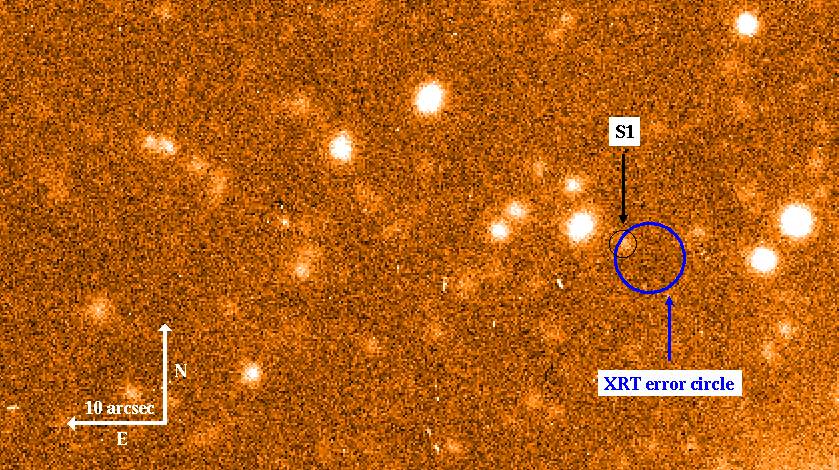
- GCN Circular #4408
J. S. Bloom (UC Berkeley), P. Challis (CfA), A. Garg (CfA), and R.
Foley (UC Berkeley) report:
"Starting at 2005-12-28 06:16:19 UT, we began imaging the field of
GRB 051227 (GCNs 4397, 4400, 4401, 4403) with the Magellan 6.5m +
LDSS3 instrument (*). At an airmass of 2.1 the effective seeing was
0.62 arcsec. In each five minute exposure we detect the faint VLT
sources noted by Malesani et al. (GCNs 4404, 4407) near the XRT
localization (Beardmore et al., GCN 4402). Photometric analysis is
ongoing. We fit an astrometric world coordinate system using more
than one hundred objects common between the LDSS3 imaging and SDSS
(Cool et al. 4399) with an rms of 85 mas in each coordinate. Our
location of the possibly transient source (Malesani et al.; GCN 4407)
is (J2000):
RA 08:20:58.109
DEC +31:55:31.89
with a statistical uncertainty of 210 mas in each coordinate from
centroiding uncertainty. The absolute uncertainty is ~250 mas,
assuming 100 mas error in the absolute SDSS WCS. This is 1.89" S and
4.28" W of an apparent galaxy (SDSS J082058.46+315533.4; r = 22.9
mag; 08:20:58.445 +31:55:33.78). If the galaxy and the apparent
counterpart are at the redshift of the cluster (NSC J082047+315700 as
noted by Barbier GCN# 4397; z = 0.1753; Gal et al. 2003), then this
offset would amount to 13.7 kpc in projection."
A comparison finding chart between tonight's imaging with SDSS can be
found at:
http://astro.berkeley.edu/~jbloom/grb051227-ldss.ps
This message may be cited.
(*) http://www.ociw.edu/lco/magellan/instruments/LDSS3/
- GCN Circular #4409
R. J. Foley, J. S. Bloom (UC Berkeley), J. X. Prochaska, G. D.
Illingworth, B. P. Holden, D. Magee (UCO/Lick), P. Challis, and A. Garg
(CfA) report:
"We obtained 2x1500 sec spectra of the object found inside, S1 (GCN 4404,
4407, 4408), and the galaxy north-east, G1 (GCN 4408), of the XRT error
box of GRB 051227 (GCN 4402) with Keck II (+ DEIMOS). We detect
absorption lines at the position of the galaxy which we identify as Ca II
H&K at z = 0.714. We also detect emission lines which we identify as
[O II] 3727 and H beta.
If the GRB afterglow is S1 and at this redshift, then the offset from G1
to S1 would amount to 33.7 kpc in projection."
- GCN Circular #4410
E. Berger (Carnegie Observatories) reports:
"We imaged the error circle of GRB 051227 (GCNs 4397,4401) with GMOS on
the Gemini-north telescope starting on 2005, Dec. 28.33 UT (13.88 hr after
the burst). A total of 25 min were obtained in r-band in good seeing
conditions (0.75"). Within the refined XRT position (GCN 4402) we detect
source S1 (GCNs 4404,4407,4408) at coordinates (J2000):
RA = 08:20:58.107
DEC= +31:55:32.01
We also detect an additional faint source about 0.7" outside of the XRT
error circle (S2) which is not clearly visible in the finders provided by
Malesani et al. (GCN 4407) and Bloom et al. (GCN 4408) at coordinates:
RA = 08:20:57.773
DEC= +31:55:26.67
Using several nearby stars with SDSS calibration (GCN 4399) we determine
that source S1 has r=24.8+/-0.15 mag, while source S2 has r=25.5+/-0.25
mag. Since previous GCNs do not provide photometry of source S1 we are
unable to determine whether it has varied in brightness compared to
earlier observations.
A finding chart showing objects S1 and S2 is available at:
http://www.ociw.edu/~eberger/grb051227-gemini.ps
Further Gemini observations are planned."
- GCN Circular #4411
P. Roming (PSU), L. Barbier (GSFC), M. Trippico (GSFC-SSAI), J. Nousek
(PSU) on behalf of the Swift/UVOT team
We have created summed images from Swift UVOT exposures of GRB051227
(Barbier et al., GCN 4397) taken through each of the broadband filters. No
source was detected at the XRT position (Beardmore et al. GCN 4402) or the
R-band VLT position (Malesani, GCN 4404) down to the
following 5-sigma upper limits (no correction has been made for the
expected visual extinction of about 0.14 magnitudes):
Filter T_range(s) Tot Exp(s) 5sigUL(mag)
V 96-4092 496 19.0
B 462-10250 617 20.2
U 408-6370 502 19.6
UVW1 354-5904 950 19.6
UVM2 300-4996 950 19.7
UVW2 571-3988 113 18.5
White 516-565 100 19.2
We note that from the U-band summed image a source is detected by the Swift
analysis tool, uvotsource, at the 4.0-sigma confidence coincident with the
position reported by Malesani. The magnitude is 19.8+/-0.3.
- GCN Circular #4412
D. Malesani (SISSA), S. Covino (INAF/OABr), E. Depagne, C. Lidman, C.
Melo (ESO), S. Piranomonte, L.A. Antonelli (INAF/OARm), S. Campana, G.
Tagliaferri (INAF/OABr), G. Chincarini (Univ. Milano-Bicocca), M. Della
Valle (INAF/OAA), F. Fiore and L. Stella (INAF/OAR), report on behalf of
the MISTICI collaboration:
We observed again the field of GRB 051227 (Barbier et al., GCN 4397;
Hullinger et al., GCN 4400; Barthelmy et al., GCN 4401) with the ESO
VLT-UT2 equipped with FORS1. Observations started on 2005 Dec 29.1899
(1.4 d after the GRB), and secured 1 hour of net exposure in the R band.
Analysis of the first 6 frames (30 min exposure) reveals that the source
S1 individuated in the previous VLT images (Malesani et al., GCN 4404,
4407; see also Bloom et al., GCN 4408; Berger et al., GCN 4410; Roming
et al., GCN 4411) has dimmed by 1.1 +- 0.3 mag in the R band. Assuming a
power law decay, the decay slope is alpha = 0.9 +- 0.3.
This suggests that very likely S1 is the optical afterglow of GRB 051227.
This message can be cited.
- GCN Circular #4413
P. D'Avanzo, S. Covino (INAF/OABr), D. Malesani (SISSA), S. Piranomonte,
L.A. Antonelli (INAF/OAR), S. Campana (INAF/OABr), report on behalf of
the MISTICI collaboration:
We further analyzed our VLT images (Malesani et al., GCN 4404, 4412) of
GRB 051227 (Barbier et al., GCN 4397; Hullinger et al., GCN 4400;
Barthelmy et al., GCN 4401). Optimal subtraction performed with the ISIS
package on our two set of images (taken on Dec 28.2 and 29.2 UT) clearly
shows a dimming of the source S1 (Malesani et al., GCN 4404). A figure
showing the result of the subtraction can be found at the following URL:
http://www.sissa.it/~malesani/GRB/051227/subtraction.jpg
This message can be cited.

- GCN Circular #4414
A. M. Soderberg (Caltech) and E. Berger (Carnegie Observatories) report:
"We re-observed the error circle of GRB 051227 with Gemini/GMOS starting
on 2005 Dec. 29.36 UT (38.6 hr after the burst) for a total of 25 min in
r-band. Digital image subtraction performed on this image and the one
obtained on the previous night (13.9 hr after the burst; GCN 4410)
confirms that source S1 has faded, as indicated by Malesani et al. (GCN
4412) and D'Avanazo et al. (GCN 4413)."
- GCN Circular #4415
Dale A. Frail (NRAO) reports on behalf of a larger collaboration:
"We used the Very Large Array to observe the Swift burst GRB051227
(GCN 4397) at a frequency of 8.46 GHz on 2005 December 28.57 UT and
December 29.22 UT. No radio emission is detected within the XRT error
circle (GCN 4402). At the position of the optical afterglow (GCN 4408)
the formal flux density values are -21 +/- 28 uJy and 18 +/- 25,
respectively.
No further observations are planned.
The National Radio Astronomy Observatory is a facility of the National
Science Foundation operated under cooperative agreement by Associated
Universities, Inc."
- GCN Circular #4418
Kenshi Yanagisawa, Tsuyoshi Sakamoto (OAO/NAOJ), and N. Kawai (Tokyo
Tech) report on behalf of the MITSUME Collaboration:
"The field of GRB051227 (Barbier et al., GCN 4397) was observed with
the 3-color Mitsume 50cm Telescope at Okayama, Japan from 19:13 UT to
19:21 UT (1.1 to 1.4 hours after the burst), until the observation was
terminated by the cloudy weather. Coadding the 14 frames of 60 sec
exposure, we did not detect a source at the position of the afterglow
candidate noted by Malesani et al. (GCN 4404, 4407, 4412), Bloom et
al. (GCN 4408), Berger et al. (GCN 4410) and Roming et al. (GCN 4411).
The 10-sigma upper limits are g'=18.5, Rc=17.7, and Ic=17.1, which
were calibrated using the pre-burst SDSS observations (stars in the
file GRB051227_sdss.objects_magnitudes.dat, Cool et al., GCN 4399),
where the Rc and Ic magnitudes were converted from the g', r', and i'
magnitudes using the formula by Smith et al. (2002)."
- GCN Circular #4419
E. Berger (Carnegie Observatories) and A. M. Soderberg (Caltech) report:
"We re-observed the error circle of GRB 051227 with Gemini/GMOS starting
on 2005 Dec. 30.35 UT (62.6 hr after the burst) for a total of 30 min in
r-band. Source S1 is clearly detected in our summed image with
r=25.8+/-0.2 mag.
Digital subtraction performed on this image and the previous two Gemini
images obtained on nights 1 and 2 (13.9 and 38.6 hr after the burst,
respectively; GCN 4414) reveals that following a decline of about 1 mag
between nights 1 and 2 (CGNs 4412,4413,4414), there has been no change in
flux between nights 2 and 3. This suggests that unless there has been a
significant flatenning in the afterglow decay, our detection of source S1
on night 3 represents the host galaxy of GRB 051227 and that the galaxy at
z=0.714 located 4.7" to the NE (GCNs 4408,4409) is unrelated to the burst.
Thus, the offset of GRB 051227 relative to its host is negligible, and the
actual redshift of the burst is most likely higher than z=0.7.
Therefore, GRB 051227 is either one of the highest redshift short GRBs
detected to date, or given the similarity in brightness to the hosts of
long GRBs, and the ambiguity as to the nature of the burst (GCN 4401), it
is in fact a long GRB."
- GCN Circular #4421
K.V. Garimella, A.L. Homewood, D.H. Hartmann (Clemson University), and
G.D. Henson (ETSU) on behalf of the SARA Consortium and the Clemson GRB
Follow-Up Team:
We began observations of GRB 051227 (Barbier et al, GCN 4397) beginning
December 28th, 06:20:31UT and ending 07:36:35UT approximately 12 hours
after the Swift Trigger (trigger=174738). We obtained 15 300-second
exposures in R-band with the SARA 0.9m telescope on Kitt Peak. Coadding
all exposures and comparing with the USNO A2.0 catalog reveals no new
source down to a detection limit of R=21.55 +/- 0.20 mag.
The SARA website can be found at
http://www.saraobservatory.org
The Clemson University GRB Response Site can be found at
http://people.clemson.edu/~kgarime/burst/
This message may be cited.
- GCN Circular #4627
Richard J. Cool (University of Arizona) reports:
Based upon feedback from users of our online releases of SDSS photometry
and astrometry of GRB fields, we have discovered an error in several past
releases. In preparing the releases, we inadvertently neglected to remove
duplicate listings of several objects from the online catalogs. Several
of the secondary observations of the objects included are of lower
photometric quality than the primary observation and thus photometric
zeropoints derived with them may shift slightly. We removed all duplicate
observations from the online catalogs for past
bursts located at
http://mizar.as.arizona.edu/grb/public/.
We apologize for any inconvenience.
- GCN Circular #5191
N. Kodaka, Y. Urata, M. Tashiro, K. Abe, K. Onda, K. Masuno (Saitama-U),
F. Usui (ISAS/JAXA), M. Kuwahara (TUS/RIKEN), T. Tamagawa (RIKEN) report:
"We observed the error region of GRB 051227 (Barbier et al. GCN 4397)
with the very wide-field camera WIDGET located at Akeno, Japan. WIDGET
monitored the region continuously with repeat of unfiltered 5-second
exposures between 187 minutes before and 12 minutes after the burst
trigger. We did not find any optical emission at the Swift XRT source
position (Beardmore et al. GCN 4402). The 1-sigma limiting magnitude
of each frame derived by the Tycho-2 catalog was around V=10.9
magnitudes."
This message may be cited.
- A&A 498, 711 from 11 Mar 09
D'Avanzo et al.: likely redshift = 0.8
![]() Previous IAU Circulars
Previous IAU Circulars 





